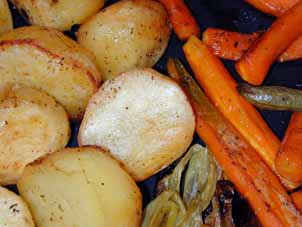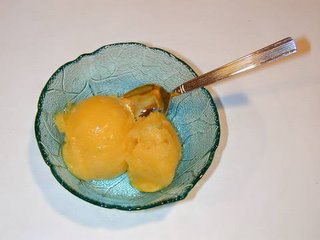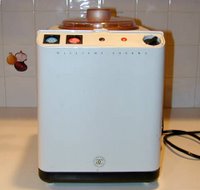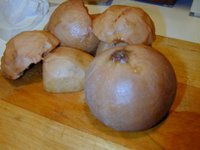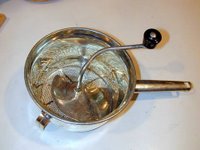
Thanksgiving Dinner
Thanksgiving is my favorite holiday. No surprise there. Of course I like the food related aspects of the holiday, but more important is consciously appreciating that food and giving thanks for being able to have it and share it with family and friends. And, at least thus far, Thanksgiving has yet to reach the level of crass commercialism that nowadays plagues Christmas.
Since Ms Issippi was up from the Delta to partake in Thanksgiving, a few themes and constraints were suggested. She is a vegetarian (but will eat seafood), so we needed a little accommodation, and we wanted a menu that echoed the South, but also reflected our New England home and gave a nod to our European background. Here’s what we came up with:
Prelude
Nuts and Tangerines
First Course
Lobster with homemade mayonnaise on Endive
Veuve Clicquot Ponsardin Champagne NV
Main Courses
Brined, Maple Glazed Turkey with Pan Gravy
Cranberry Cumberland Sauce
Mississippi-style Cornbread Stuffing
Sautéed Mushrooms with Rosemary
Roasted Brussels Sprouts with Chestnuts
Rum Glazed Sweet Potatoes
Ken Wright Cellars, Pinto Noir, Nysa Vineyards 2000
 Intermezzo
IntermezzoHomemade Lemon Rosemary Sorbet
Cheese Course
Italian Bricco Cheese with Membrillo
Desserts
Pumpkin Pie with Vanilla Ice Cream
Tarte Tatin aux Poires
Domaine de a Motte - Coteaux du Layon Rochefort 1979
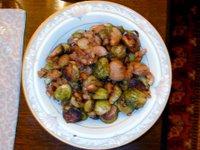 Peggy Knickerbocker’s “Simple Soirees” provided the base for the menu and was the source for Cornbread Stuffing and Sweet Potato recipes as well as the starting point for the Lobster and Endive first course. To remain vegetarian, I used butter rather than bacon fat for the stuffing and baked it separately with vegetable stock for moistening. The Cranberry Cumberland sauce is a modified version of a recipe found in “The Vegetarian Epicure” by Anna Thomas, my original hippy cookbook. It’s the only dish that I make every Thanksgiving for continuity. Everything else is open to experimentation or substitution.
Peggy Knickerbocker’s “Simple Soirees” provided the base for the menu and was the source for Cornbread Stuffing and Sweet Potato recipes as well as the starting point for the Lobster and Endive first course. To remain vegetarian, I used butter rather than bacon fat for the stuffing and baked it separately with vegetable stock for moistening. The Cranberry Cumberland sauce is a modified version of a recipe found in “The Vegetarian Epicure” by Anna Thomas, my original hippy cookbook. It’s the only dish that I make every Thanksgiving for continuity. Everything else is open to experimentation or substitution. For the turkey, I definitely think brining is the way to go. The result is a much juicer turkey for the dinner and far tastier leftovers for sandwiches.
For the turkey, I definitely think brining is the way to go. The result is a much juicer turkey for the dinner and far tastier leftovers for sandwiches.Brined Turkey with Vermont Maple Syrup Glaze
- 1 10-12 lb free range, fresh turkey
Brine
- 1 gallon water
- 2 cups kosher salt
- 1 cup dark brown sugar
- 1 Tablespoon allspice berries
- 2 tablespoons black peppercorns
- ½ cup whiskey
- Plenty of ice
- 1 gallon ice water
- Large plastic bin
- Two large plastic bags (trash bag sized)
Maple Glaze
- 1 cup chicken or turkey stock
- 1 stick butter
- ½ cup Vermont Maple syrup
- Salt and pepper to taste
Start early the night before. In a large pot, mix together the first gallon of water, salt sugar, allspice and peppercorns. Bring to a boil and ensure the salt and sugar are fully dissolved. Allow to fully cool. If possible, cool further in the refrigerator or outside to get the liquid to refrigerator temperature. Mean time, remove the turkey gizzards, etc. and rinse the turkey well. Dry the turkey and rinse its inner cavity with whiskey to knock off any lingering odors. Don’t worry about draining the whiskey, it will add flavor to the brine!
Mix some of the ice with water to create the second gallon of ice water and add to the pot of cooled brine. Put the turkey in the first plastic bag, then into the second (for strength!). Place in the plastic bin. With help, pour the brine into the bag with the turkey. Squeeze out as much air as possible and seal with a twister seal. Seal the second bag as well. Set the bird breast side down to start. If your refrigerator is large enough to hold this container, you’re really luck! If not, surround the turkey with bags of ice and put the bin in a cool location. Let it brine 8 to 12 hours or so (overnight) and turn the bird on occasion if possible to ensure even brining. After brining, I remove and dry the turkey and let it air dry in the refrigerator (without the bin!) The air drying will allow the skin to crisp in the oven.
To make the maple glaze, mix together the stock, butter, maple syrup, salt and pepper. Heat to a boil, whisking thoroughly. Remove from heat.
To roast the turkey, Preheat the oven to 325 degrees. Put the turkey on a rack in a large roasting pan. I don’t stuff my turkeys, I prefer to cook the stuffing separately. Roast the turkey about 20 to 30 minutes per pound, basting every 20 to 30 minutes with the maple glaze and using pan drippings after the glaze has run out. Using a thermometer, the meat in the thickest part of the thigh should be between 165° to 170°. Allow 20 to 30 minutes to rest (covered with foil) before carving. If you like gravies, the pan drippings will make a fabulous base for one!
